Last Updated on November 15, 2025 by Emma Fajcz | Published: August 28, 2018
Trying to communicate food allergies in a different culture can be intimidating.
We all want to enjoy local food when we travel, and cosmopolitan Barcelona features plenty of options for people with varying dietary needs. However, attempting to communicate your allergies to restaurant staff—and knowing what you can and can’t eat—can be challenging at best, and have potentially serious consequences at worst. This guide to eating with allergies in Barcelona will highlight useful Spanish and Catalan vocabulary as well as common dishes containing allergens that you may want to steer clear of.
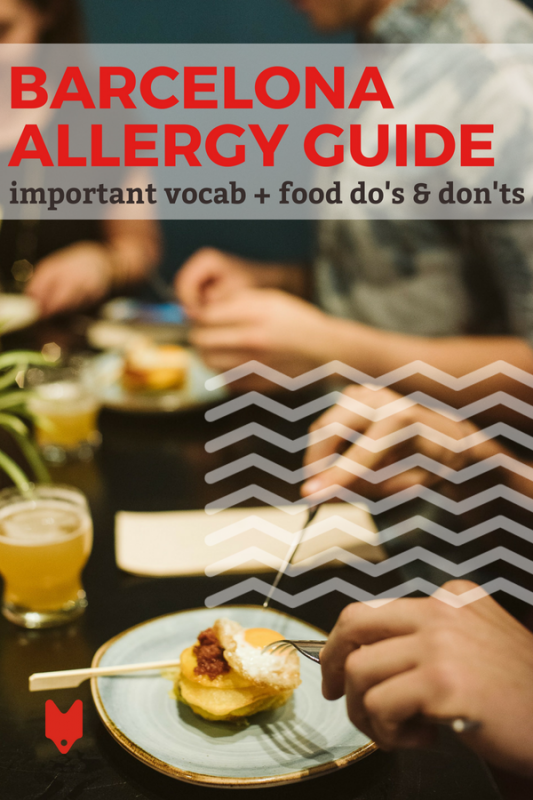
Peanut/tree nut allergies
Peanuts are not very common in Spanish and Catalan cuisine. However, to be on the safe side, we recommend that even those who only have peanut allergies familiarize themselves with this information. Tree nuts are more common and can sneak their way into many unsuspecting dishes. Here’s what you need to know as far as peanuts and tree nuts for eating with allergies in Barcelona.
Important vocabulary
The first term listed is Spanish, the second is Catalan.
- Soy alérgico/a a… / Soc al·lèrgic a = I’m allergic to…
- No puedo comer / No puc menjar… = I cannot eat…
- ¿Tienes algo que no lleve…? / Tens alguna cosa que no contingui …? = Do you have anything that does not contain…?
- ¿Esta comida contiene…? / Aquest plat conté…? = Does this dish contain…?
- frutos secos / fruits secs = tree nuts
- cacahuetes / cacauets = peanuts
- almendras / ametlles = almonds
- avellanas / avellanes = hazelnuts
- anacardos / anacards = cashews
- pistachos / pistatxos = pistacios
- castañas / castanyes = chestnuts
- nueces / nous = walnuts
- piñones / pinyons = pine nuts
- pipas / pipes de gira-sol = sunflower seeds
- ¡Gracias por tu ayuda! / Gràcies per la teva ajuda! = Thank you for your help!
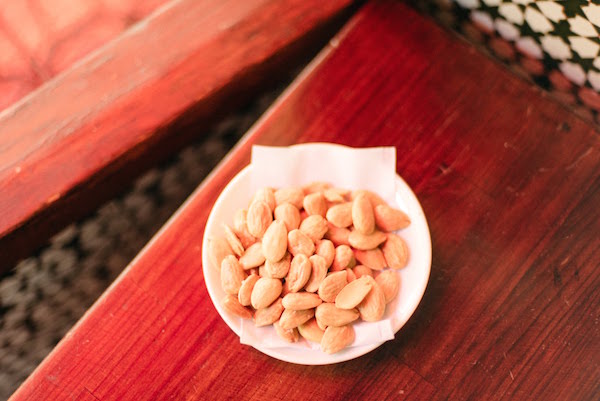
Common foods containing nuts
Guests with tree nut allergies should be cautious of any food labeled “a la catalana.” This regional twist on common dishes implies the use of pine nuts. Another local specialty, romesco sauce, makes the perfect accompaniment to grilled calçots. However, this traditional sauce includes any variety of nuts (usually almonds, hazelnuts and/or pine nuts) more often than not.
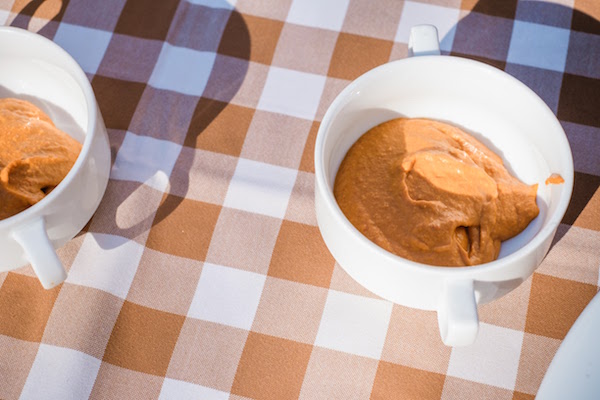
Take special care when ordering dessert. Many Catalan treats contain tree nuts. Turrón (torró in Catalan), popular around the winter holidays, comes to mind—this rich nougat is made with a large amount of almonds. Other treats like coca de Sant Joan (eaten around Sant Joan’s Day in June) and panellets (traditionally enjoyed on All Saints’ Day in November) are seemingly everywhere on certain holidays. However, both contain pine nuts, and panellets usually have almonds as well.
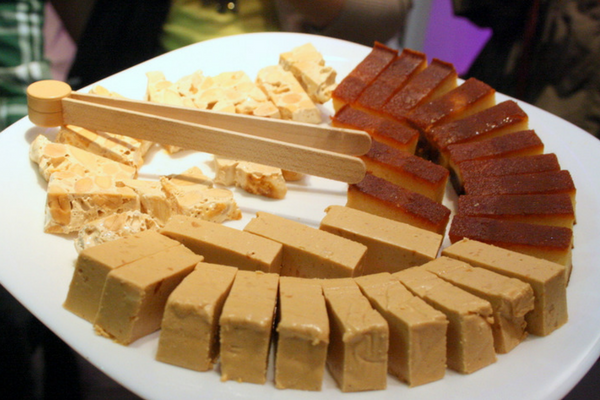
Typical nut-free foods
Fortunately for those eating with allergies in Barcelona and avoiding nuts, there are still plenty of delicious options! Most typical main dishes (with the exception of those listed above) are nut-free. That means you’re free to enjoy your potato tapas (both in bomba and bravas form), fideuà, pan con tomate and more without fear of allergens. When it comes time for dessert, there are still plenty of nut-free options, such as everyone’s favorite: crema catalana!
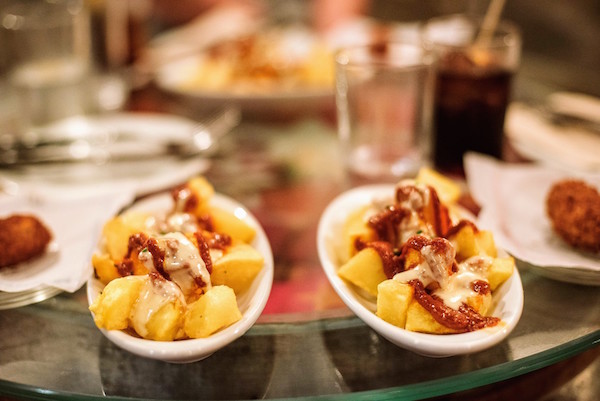
Dairy allergies
Eating with allergies in Barcelona can seem difficult if you need to avoid dairy. However, with a little bit of knowledge about common foods containing dairy and the handy vocabulary listed below, you’ll be set to eat at any local bar or restaurant.
Important vocabulary
The first term listed is Spanish, the second is Catalan.
- Soy alérgico/a a… / Soc al·lèrgic a = I’m allergic to…
- No puedo comer / No puc menjar… = I cannot eat…
- ¿Tienes algo que no lleve…? / Tens alguna cosa que no contingui …? = Do you have anything that does not contain…?
- ¿Esta comida contiene…? /Aquest plat conté…? = Does this dish contain…?
- productos lácteos / productes làctics = dairy products
- leche / llet = milk
- yogur / iogurt = yogurt
- queso / formatge = cheese
- mantequilla / mantega = butter
- nata / crema = cream
- Sin salsa por favor / Sense salsa, si us plau = No sauce, please!
- ¡Gracias por tu ayuda! / Gràcies per la teva ajuda! = Thank you for your help!
Common foods containing dairy
Be careful with anything that includes all i oli. This garlic mayonnaise is a popular condiment all throughout Spain, especially here in Barcelona, but is often made with milk instead of eggs. And unfortunately, croquettes are a no-go most of the time as well. These creamy little bites are made with bechamel sauce, which contains milk. However, many places (especially vegan restaurants) offer bechamel-free croquetas, so if you’re not sure, just ask! When it comes time for dessert, stay away from crema catalana, which has milk as a primary ingredient as well.
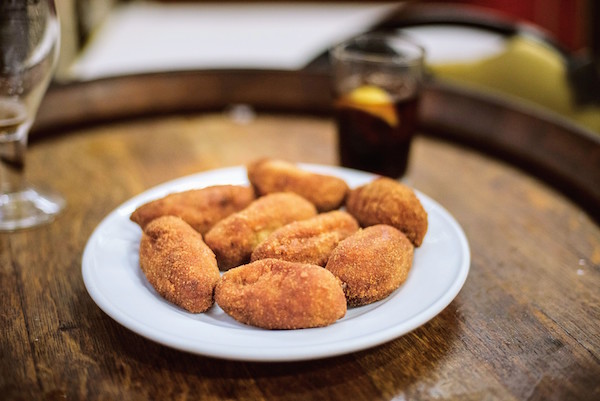
Typical dairy-free foods
Many restaurants offer fabulous grilled meats and fish that make great options for those eating with allergies in Barcelona and avoiding dairy. Just look for anything “a la plancha”—that just means the dish has been simply seasoned and grilled to perfection. No need to worry about whether or not there’s a sauce that may or may not contain dairy! Many staple dishes of the Catalan diet are also dairy-free. We particularly love esqueixada, a refreshing tapa made with salt cod, tomatoes, olives, onions and peppers.
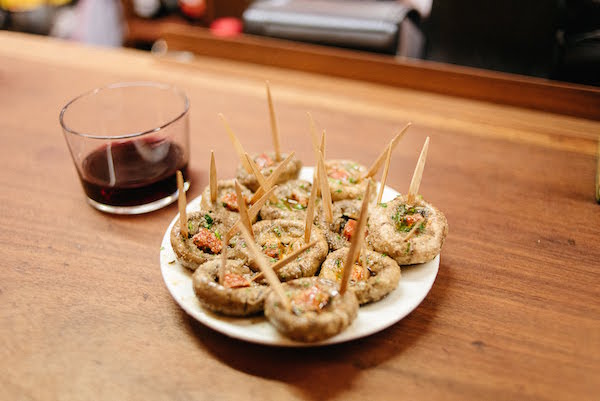
Gluten allergies/intolerance
Whether you’re celiac or just prefer to stay away from gluten, our guide to eating gluten free in Barcelona is a must! In the meantime, here’s a crash course in avoiding gluten in Barcelona.
Important vocabulary
The first term listed is Spanish, the second is Catalan.
- Enfermedad celiaca / celiaquia = celiac disease
- Yo soy celiaco/a / Jo soc celíac = I’m celiac
- No puedo comer productos que tengan como ingrediente: trigo, centeno, cebada o avena / No puc menjar productes que tinguin com a ingredient: blat, sègol, ordi o civada = I cannot eat things that contain wheat, rye, barley or oats.
- Libre de gluten / Sense gluten = gluten-free
- Almidón de trigo / Midó de blat = wheat starch
- Soy celiaco/a y debo seguir una dieta sin gluten / Sóc celíac i he de seguir una dieta sense gluten = I’m celiac and must follow a gluten-free diet
- ¿Esta comida contiene trigo, centeno, cebada o avena? / Aquest menjar conté blat, sègol, ordi o civada? = Does this dish contain wheat, rye, barley, or oats?
- Puedo comer alimentos que contengan arroz, patatas, verduras y frutas, huevos, queso, leche y pescado / Puc menjar aliments que continguin arròs, patates, verdures i fruites, ous, formatge, llet i peix = I can eat dishes with rice, potatoes, vegetables, fruit, eggs, cheese, milk, and fish.
- Sin salsa por favor / Sense salsa si us plau = No sauce please!
- Gracias por tu ayuda / Gràcies per la teva ajuda = Thank you for your help!
Common foods containing gluten
Many tourists come to Barcelona in search of paella, but more often than not, you’ll find locals chowing down on hearty fideuà instead. It’s similar to its popular Valencian counterpart, but made with noodles rather than rice (and plenty of seafood, too!). Another common Catalan staple is pan con tomate, or bread rubbed with fresh tomato, which is as popular at breakfast as it is as an evening tapa. Celiacs and other gluten-free diners should stay away from these two dishes, unless you know for certain that you’re at a place that uses gluten-free noodles or bread.
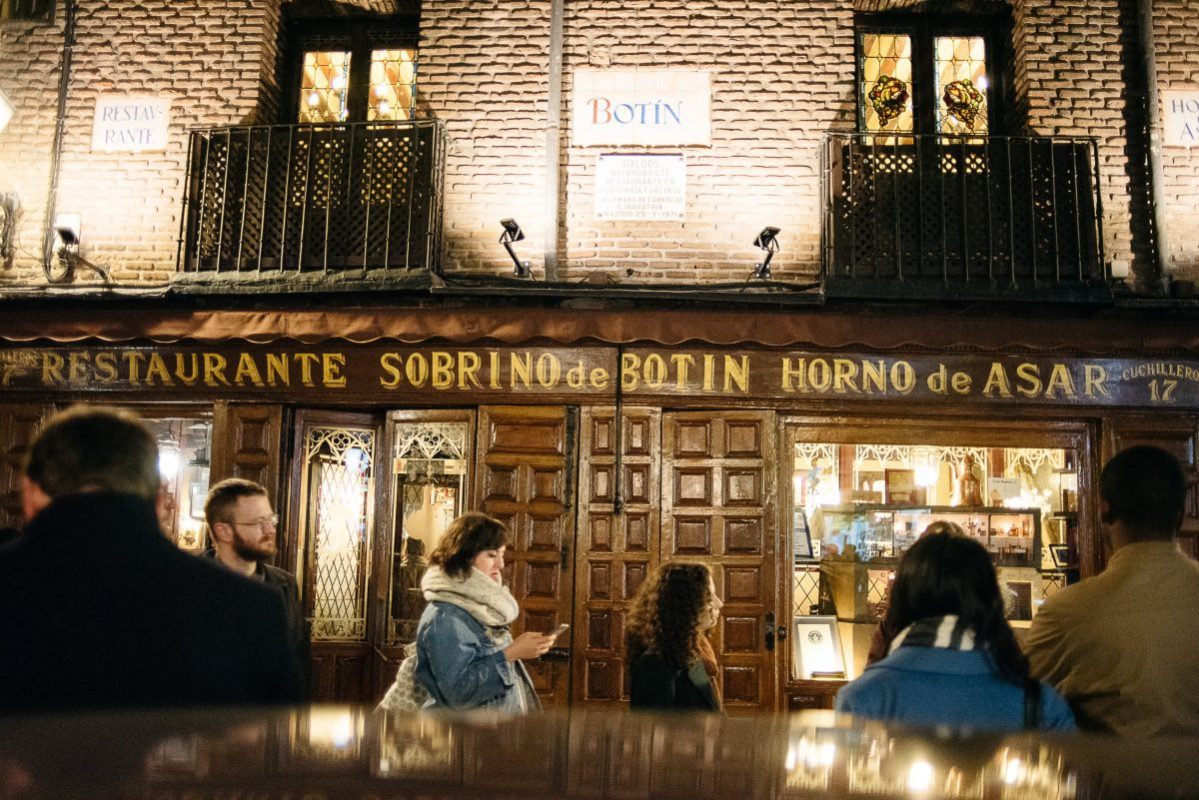
Typical gluten-free foods
It’s completely possible to eat like a local without any gluten at all! One of our all-time favorite Barcelona dishes is escalivada. This simple roast vegetable salad is especially delicious in the summer! We also love esqueixada, mentioned above, as a simple and refreshing gluten-free dish. But wait, there’s more: some of the most popular Spanish dishes such as patatas bravas, tortilla, and pimientos de padrón are all gluten-free as well!

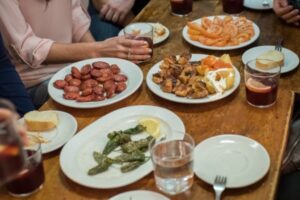







Great write-up Lindsey! Not sure if you still monitor this site, but this is a bit of a last minute hail Mary! We’re actually heading to Barcelona tomorrow afternoon, and we are having trouble finding anything online about places that may cater to people with tree nut allergies… we’ll be staying on Placa de la Vila de Gracia on Monday night, so my question is, do you know of any restaurants, or have any recommendations, for a dinner spot that might be able to accommodate a tree nut allergy? Any help would be greatly appreciated! Thank you so much!
Hey Kiel! Though you should definitely look out for tree nuts while eating out (especially almonds and that sneaky romesco sauce), we’re not familiar with any specific nut-allergy-friendly spots. Most should be able to accommodate you. Just go prepared with the vocab and traditionally nut-free dishes included in this post. Here are some of our favorite spots in Gracia: http://devourbarcelonafoodtours.com/where-to-eat-in-barcelona-gracia/
They do sell peanuts here. One tapas place fries in 50% peanut oil. You need to be clear about very very allergic. There is not a lot of understanding about cross contamination until you speak to several people. Shellfish allergy (crustaceans) is really difficult to navigate.
Thanks for your comment Elizabeth! That’s a good point about peanut oil and we definitely agree that people with allergies need to communicate them to bar and waitstaff—being insistent and overcommunicating is better in the case of severe allergies.
“Be careful with anything that includes all i oli. This garlic mayonnaise is a popular condiment all throughout Spain, especially here in Barcelona, but is often made with milk instead of eggs.”
Milk instead of eggs?
All i oli is NOT made with eggs or milk — WTF? — it is made with garlic and oil. Basta.
Good point, Bill—while the traditional version of alioli is only made with garlic and oil, many modern versions are made with eggs or even milk. In fact, the latter is common at many restaurants in Spain due to food safety regulations restricting the use of raw egg in sauces such as mayonnaise. We hope this clears things up.